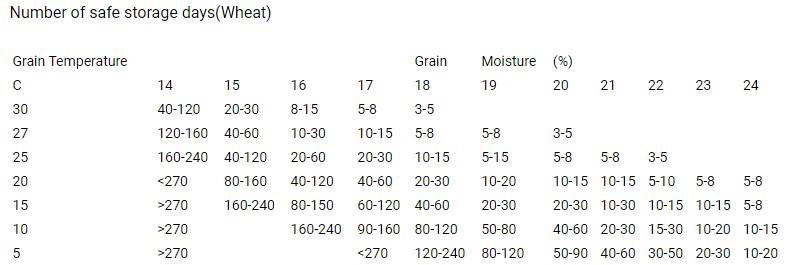Grain conditioning is a widely used term that can be used to identify situations where either aeration or natural air drying is being utilized. Knowing the difference between aeration and natural air drying will aid in selecting aeration systems,equipment, and storage that will best suit your needs.
Firstly, it is important to know the difference between aeration and natural air drying. When aerating, only a small amount of airflow is required, 0.1 to 0.2 cfm/bu. Aeration involves moving a small amount of air through a pile of grain to cool and preserve the quality of grain. When used properly aeration will:
• Cool and maintain grain quality in long term storage
• Cool grain that has been harvested at temperatures above safe storage temperatures
• Preserve grain quality while holding grain in a wet bin until it can be dried
• Cool grain that has been dried in a dryer
The process of natural air drying requires much more airflow, 0.75 to 2 cfm/bu is required depending on the crop being stored. When naturally air drying, your goal is to remove moisture from the grain enabling it to be stored at safe moisture levels. Points to look for in a natural air drying system are:
• Airflow levels in cereal grains of 0.75 to 1 cfm/bu
• Airflow levels in oil seeds of 1 to 2 cfm/bu
• Ambient air temperatures at a minimum of 10° Celsius
• Aeration system that will provide uniform airflow
• Storage facilities with adequate ventilation
Determining whether you require a storage bin to be an aeration bin or a drying bin is a decision that should be made when you are planning a bin site, or adding to or improving a storage location. If you are setting up a new site and will be incorporating a dryer into the site, aeration bins may be what you are looking for. If you are setting up a row of smaller hopper bottom bins and typically run into wet or late harvests, you may look towards natural air drying as an option. Either way, the most important thing you can do when it comes to storage is to have the option of moving air through your grain and monitoring on a regular basis.
When it comes to determining the appropriate aeration system for your conditioning needs, there are a number of points to consider:
• Are you wanting to aerate or naturally air dry?
• What crops will be stored?
• What is the availability of power at the site?
• Will a dryer be part of the system?
• Will wet grain as well as dry grain be stored on site?
• What is the required bushel capacity?
• Will there be a need to expand the storage site in the future?
Once you have determined your requirements, the next step is to plan your site. With the assistance of an AGI Dealer or Representative, you will receive guidance as to which bin/aeration/fan/monitor combination will work best for your site. It is important to remember that if you set a bin up for natural air drying you will always be able to use the bin for aeration. If you set a bin up for aeration, and determine later that you would like to use it for drying, you will likely need to change or adapt your system to do so.Knowing the capabilities of your system from the start will help you manage your harvest and storage as you proceed through the seasons.
To preserve quality and store grain safely, the grain mass needs to be cool and relatively dry. To achieve this, it is beneficial to pair your bin aeration system with a bin monitoring system. A monitoring system will keep you informed of temperatures and possibly moisture conditions in your bin. When temperatures start to rise in your bin, or progress to unsafe levels, utilizing an aeration system to cool grain will help preserve the quality of your grain.
Safe storage charts for grains are an important tool to utilize, an example of one for Wheat and another for Canola are included below.

Number of safe storage days(Canola)
As you can see in the charts, managing temperature and moisture levels in stored grain can make a vast difference in the range of safe storage periods. If you maintain low moisture and temperature levels, safe storage can be measured in months. Conversely, having high moisture grain coupled with high temperatures can put your grain at risk within a few days.Whether you are looking to aerate or naturally air dry, having a system in place to move air through your grain is an important farm management tool. Coupling your aeration system with a monitoring system goes a long way to ensuring successful on-farm storage, both short term and long term.